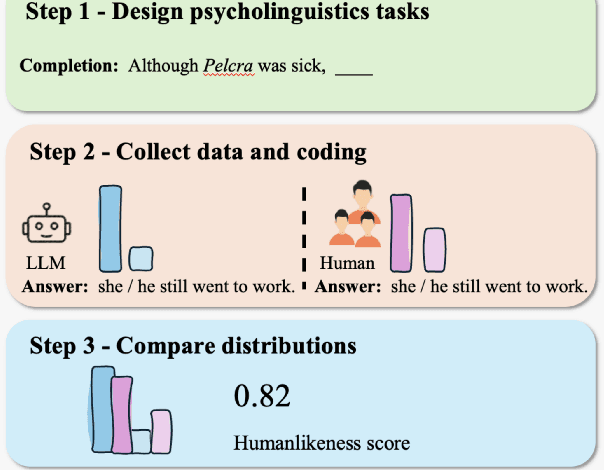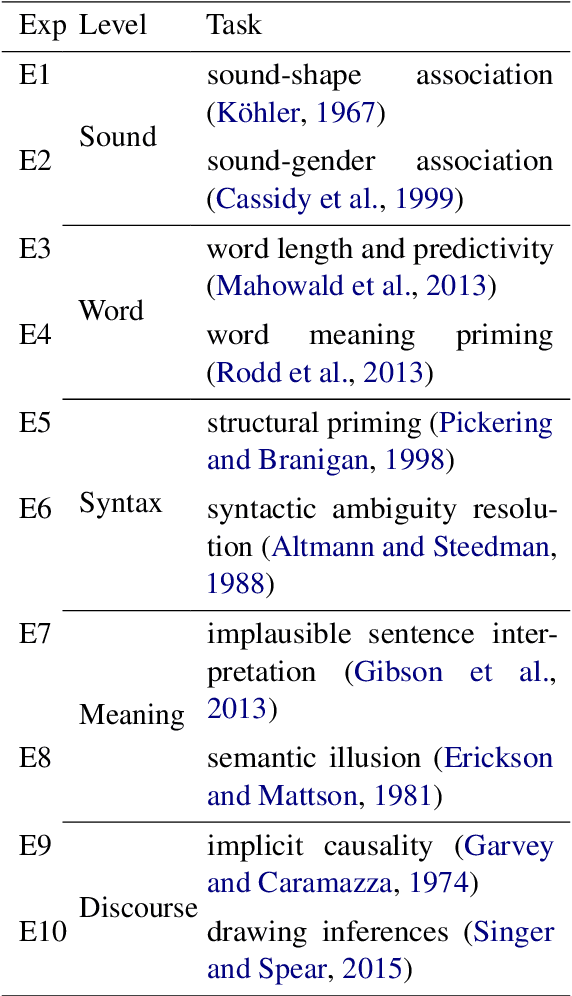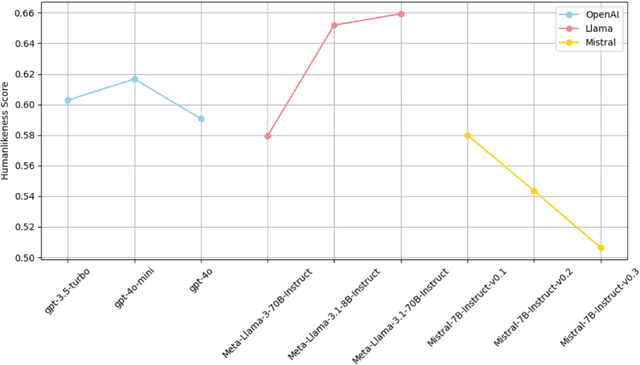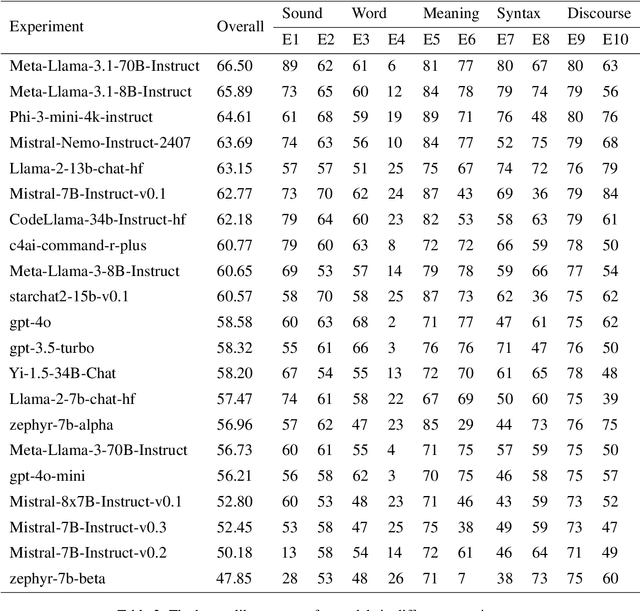Xufeng Duan
How Syntax Specialization Emerges in Language Models
May 26, 2025Abstract:Large language models (LLMs) have been found to develop surprising internal specializations: Individual neurons, attention heads, and circuits become selectively sensitive to syntactic structure, reflecting patterns observed in the human brain. While this specialization is well-documented, how it emerges during training and what influences its development remains largely unknown. In this work, we tap into the black box of specialization by tracking its formation over time. By quantifying internal syntactic consistency across minimal pairs from various syntactic phenomena, we identify a clear developmental trajectory: Syntactic sensitivity emerges gradually, concentrates in specific layers, and exhibits a 'critical period' of rapid internal specialization. This process is consistent across architectures and initialization parameters (e.g., random seeds), and is influenced by model scale and training data. We therefore reveal not only where syntax arises in LLMs but also how some models internalize it during training. To support future research, we will release the code, models, and training checkpoints upon acceptance.
Distinct social-linguistic processing between humans and large audio-language models: Evidence from model-brain alignment
Mar 25, 2025



Abstract:Voice-based AI development faces unique challenges in processing both linguistic and paralinguistic information. This study compares how large audio-language models (LALMs) and humans integrate speaker characteristics during speech comprehension, asking whether LALMs process speaker-contextualized language in ways that parallel human cognitive mechanisms. We compared two LALMs' (Qwen2-Audio and Ultravox 0.5) processing patterns with human EEG responses. Using surprisal and entropy metrics from the models, we analyzed their sensitivity to speaker-content incongruency across social stereotype violations (e.g., a man claiming to regularly get manicures) and biological knowledge violations (e.g., a man claiming to be pregnant). Results revealed that Qwen2-Audio exhibited increased surprisal for speaker-incongruent content and its surprisal values significantly predicted human N400 responses, while Ultravox 0.5 showed limited sensitivity to speaker characteristics. Importantly, neither model replicated the human-like processing distinction between social violations (eliciting N400 effects) and biological violations (eliciting P600 effects). These findings reveal both the potential and limitations of current LALMs in processing speaker-contextualized language, and suggest differences in social-linguistic processing mechanisms between humans and LALMs.
Are LLMs Good Literature Review Writers? Evaluating the Literature Review Writing Ability of Large Language Models
Dec 18, 2024



Abstract:The literature review is a crucial form of academic writing that involves complex processes of literature collection, organization, and summarization. The emergence of large language models (LLMs) has introduced promising tools to automate these processes. However, their actual capabilities in writing comprehensive literature reviews remain underexplored, such as whether they can generate accurate and reliable references. To address this gap, we propose a framework to assess the literature review writing ability of LLMs automatically. We evaluate the performance of LLMs across three tasks: generating references, writing abstracts, and writing literature reviews. We employ external tools for a multidimensional evaluation, which includes assessing hallucination rates in references, semantic coverage, and factual consistency with human-written context. By analyzing the experimental results, we find that, despite advancements, even the most sophisticated models still cannot avoid generating hallucinated references. Additionally, different models exhibit varying performance in literature review writing across different disciplines.
Unveiling Language Competence Neurons: A Psycholinguistic Approach to Model Interpretability
Sep 24, 2024Abstract:As large language models (LLMs) become advance in their linguistic capacity, understanding how they capture aspects of language competence remains a significant challenge. This study therefore employs psycholinguistic paradigms, which are well-suited for probing deeper cognitive aspects of language processing, to explore neuron-level representations in language model across three tasks: sound-shape association, sound-gender association, and implicit causality. Our findings indicate that while GPT-2-XL struggles with the sound-shape task, it demonstrates human-like abilities in both sound-gender association and implicit causality. Targeted neuron ablation and activation manipulation reveal a crucial relationship: when GPT-2-XL displays a linguistic ability, specific neurons correspond to that competence; conversely, the absence of such an ability indicates a lack of specialized neurons. This study is the first to utilize psycholinguistic experiments to investigate deep language competence at the neuron level, providing a new level of granularity in model interpretability and insights into the internal mechanisms driving language ability in transformer based LLMs.
HLB: Benchmarking LLMs' Humanlikeness in Language Use
Sep 24, 2024



Abstract:As synthetic data becomes increasingly prevalent in training language models, particularly through generated dialogue, concerns have emerged that these models may deviate from authentic human language patterns, potentially losing the richness and creativity inherent in human communication. This highlights the critical need to assess the humanlikeness of language models in real-world language use. In this paper, we present a comprehensive humanlikeness benchmark (HLB) evaluating 20 large language models (LLMs) using 10 psycholinguistic experiments designed to probe core linguistic aspects, including sound, word, syntax, semantics, and discourse (see https://huggingface.co/spaces/XufengDuan/HumanLikeness). To anchor these comparisons, we collected responses from over 2,000 human participants and compared them to outputs from the LLMs in these experiments. For rigorous evaluation, we developed a coding algorithm that accurately identified language use patterns, enabling the extraction of response distributions for each task. By comparing the response distributions between human participants and LLMs, we quantified humanlikeness through distributional similarity. Our results reveal fine-grained differences in how well LLMs replicate human responses across various linguistic levels. Importantly, we found that improvements in other performance metrics did not necessarily lead to greater humanlikeness, and in some cases, even resulted in a decline. By introducing psycholinguistic methods to model evaluation, this benchmark offers the first framework for systematically assessing the humanlikeness of LLMs in language use.
Grammaticality Representation in ChatGPT as Compared to Linguists and Laypeople
Jun 17, 2024



Abstract:Large language models (LLMs) have demonstrated exceptional performance across various linguistic tasks. However, it remains uncertain whether LLMs have developed human-like fine-grained grammatical intuition. This preregistered study (https://osf.io/t5nes) presents the first large-scale investigation of ChatGPT's grammatical intuition, building upon a previous study that collected laypeople's grammatical judgments on 148 linguistic phenomena that linguists judged to be grammatical, ungrammatical, or marginally grammatical (Sprouse, Schutze, & Almeida, 2013). Our primary focus was to compare ChatGPT with both laypeople and linguists in the judgement of these linguistic constructions. In Experiment 1, ChatGPT assigned ratings to sentences based on a given reference sentence. Experiment 2 involved rating sentences on a 7-point scale, and Experiment 3 asked ChatGPT to choose the more grammatical sentence from a pair. Overall, our findings demonstrate convergence rates ranging from 73% to 95% between ChatGPT and linguists, with an overall point-estimate of 89%. Significant correlations were also found between ChatGPT and laypeople across all tasks, though the correlation strength varied by task. We attribute these results to the psychometric nature of the judgment tasks and the differences in language processing styles between humans and LLMs.
MacBehaviour: An R package for behavioural experimentation on large language models
May 13, 2024Abstract:There has been increasing interest in investigating the behaviours of large language models (LLMs) and LLM-powered chatbots by treating an LLM as a participant in a psychological experiment. We therefore developed an R package called "MacBehaviour" that aims to interact with more than 60 language models in one package (e.g., OpenAI's GPT family, the Claude family, Gemini, Llama family, and open-source models) and streamline the experimental process of LLMs behaviour experiments. The package offers a comprehensive set of functions designed for LLM experiments, covering experiment design, stimuli presentation, model behaviour manipulation, logging response and token probability. To demonstrate the utility and effectiveness of "MacBehaviour," we conducted three validation experiments on three LLMs (GPT-3.5, Llama-2 7B, and Vicuna-1.5 13B) to replicate sound-gender association in LLMs. The results consistently showed that they exhibit human-like tendencies to infer gender from novel personal names based on their phonology, as previously demonstrated (Cai et al., 2023). In summary, "MacBehaviour" is an R package for machine behaviour studies which offers a user-friendly interface and comprehensive features to simplify and standardize the experimental process.
Does ChatGPT resemble humans in language use?
Mar 10, 2023


Abstract:Large language models (LLMs) and LLM-driven chatbots such as ChatGPT have shown remarkable capacities in comprehending and producing language. However, their internal workings remain a black box in cognitive terms, and it is unclear whether LLMs and chatbots can develop humanlike characteristics in language use. Cognitive scientists have devised many experiments that probe, and have made great progress in explaining, how people process language. We subjected ChatGPT to 12 of these experiments, pre-registered and with 1,000 runs per experiment. In 10 of them, ChatGPT replicated the human pattern of language use. It associated unfamiliar words with different meanings depending on their forms, continued to access recently encountered meanings of ambiguous words, reused recent sentence structures, reinterpreted implausible sentences that were likely to have been corrupted by noise, glossed over errors, drew reasonable inferences, associated causality with different discourse entities according to verb semantics, and accessed different meanings and retrieved different words depending on the identity of its interlocutor. However, unlike humans, it did not prefer using shorter words to convey less informative content and it did not use context to disambiguate syntactic ambiguities. We discuss how these convergences and divergences may occur in the transformer architecture. Overall, these experiments demonstrate that LLM-driven chatbots like ChatGPT are capable of mimicking human language processing to a great extent, and that they have the potential to provide insights into how people learn and use language.
 Add to Chrome
Add to Chrome Add to Firefox
Add to Firefox Add to Edge
Add to Edge